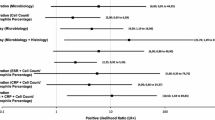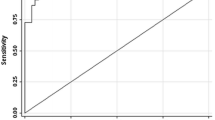Abstract
Background
The role of the synovial biopsy in the preoperative diagnosis of a periprosthetic joint infection (PJI) of the hip has not been clearly defined.
Questions/purposes
We asked whether the value of a biopsy for a PJI is greater than that of aspiration and C-reactive protein (CRP).
Methods
Before revision in 100 hip endoprostheses, we obtained CRP values, aspirated the joint, and obtained five synovial biopsy samples for bacteriologic analysis and five for histologic analysis. Microbiologic and histologic analyses of the periprosthetic tissue during revision surgery were used to verify the results of the preoperative diagnostic methods. The minimum followup was 24 months (median 32; range, 24–47 months).
Results
Forty-five of the 100 prostheses were identified as infected. The biopsy, with a combination of the bacteriologic and histologic examinations, showed the greatest diagnostic value of all the diagnostic procedures and led to a sensitivity of 82% (95% CI, ± 11%), specificity of 98% (95% CI, ± 4%), positive predictive value of 97% (95% CI, ± 5%), negative predictive value of 87% (95% CI, ± 8.3%), and accuracy of 91%.
Conclusions
The biopsy technique has a greater value than aspiration and CRP in the diagnosis of PJI of the hip (Masri et al. J Arthroplasty 22:72–78, 2007). In patients with a negative aspirate, but increased CRP or clinical signs of infection, we regard biopsy to be preferable to just repeating the aspiration.
Level of Evidence
Level II prognostic study. See Guidelines for Authors for a complete description of levels of evidence.
Similar content being viewed by others
References
AAOS Work Group. The diagnosis of periprosthetic joint infections of the hip and knee: guideline and evidence report. Available at: http://www.aaos.org/research/guidelines/PJIguideline.pdf. Accessed June 21, 2012.
Ali F, Wilkinson JM, Cooper JR, Kerry RM, Hamer AJ, Norman P, Stockley I. Accuracy of joint aspiration for the preoperative diagnosis of infection in total hip arthroplasty. J Arthroplasty. 2006;21:221–226.
Antti-Poika I, Josefsson G, Konttinen Y, Lidgren L, Santavirta S, Sanzén L. Hip arthroplasty infection: current concepts. Acta Orthop Scand. 1990;61:163–169.
Atkins BL, Athanasou N, Deeks JJ, Crook DW, Simpson H, Peto TE, McLardy-Smith P, Berendt AR. Prospective evaluation of criteria for microbiological diagnosis of prosthetic-joint infection at revision arthroplasty. The OSIRIS Collaborative Study Group. J Clin Microbiol.1998;36:2932–2939.
Barrack RL, Harris WH. The value of aspiration of the hip joint before revision total hip arthroplasty. J Bone Joint Surg Am. 1993;75:66–76.
Bori G, Soriano A, García S, Mallofré C, Riba J, Mensa J. Usefulness of histological analysis for predicting the presence of microorganisms at the time of reimplantation after hip resection arthroplasty for the treatment of infection. J Bone Joint Surg Am. 2007;89:1232–1237.
Botser IB, Smith TW Jr, Nasser R, Domb BG. Open surgical dislocation versus arthroscopy for femoroacetabular impingement: a comparison of clinical outcomes. Arthroscopy. 2011;27:270–278.
Brand RA, Pederson DR, Yoder SA. How definition of “loosening” affects the incidence of loose total hip reconstructions. Clin Orthop Relat Res. 1986;210:185–191.
Buttaro MA, Tanoira I, Comba F, Piccaluga F. Combining C-reactive protein and Interleukin-6 may be useful to detect periprosthetic hip infection. Clin Orthop Relat Res. 2010;468:3263–3267.
CLSI. Performance Standards for Antimicrobial Susceptibility Testing. Twentieth Informational Supplement. CLSI document M100-S20. Wayne, PA: Clinical and Laboratory Standards Institute; 2010.
Costerton JW. Biofilm theory can guide the treatment of device-related orthopaedic infections. Clin Orthop Relat Res. 2005;437:7–11.
Della Valle CJ, Zuckermann JD, Di Cesare PE. Periprosthetic sepsis. Clin Orthop Relat Res. 2004;420:26–31.
Fehring TK, Cohen B. Aspiration as a guide to sepsis in revision total hip arthroplasty. J Arthroplasty. 1996;11:543–547.
Feldman DS, Lonner JH, Desai P, Zuckerman JD. The role of intraoperative frozen sections in revision total joint arthroplasty. J Bone Joint Surg Am. 1995;77:1807–1813.
Fink B. Revision of late periprosthetic infections of total hip endoprostheses: pros and cons of different concepts. Int J Med Sci. 2009;6:287–295.
Fink B, Grossmann A, Fuerst M, Schäfer P, Frommelt L. Two-stage cementless revision of infected hip endoprostheses. Clin Orthop Relat Res. 2009;467:1848–1858.
Fink B, Makowiak C, Fuerst M, Berger I, Schäfer P, Frommelt L. The values of synovial biopsy and joint aspiration in the diagnosis of late peri-prosthetic infection of total knee replacements. J Bone Joint Surg Br. 2008;90:874–878.
Fitzgerald RH Jr. Total hip arthroplasty sepsis: prevention and diagnosis. Orthop Clin North Am. 1992;23:259–264.
Frommelt L. [Diagnosis and treatment of foreign-body-associated infection in orthopaedic surgery][in German]. Orthopäde. 2009;38:806–811.
Glithero PR, Grigoris P, Harding LK, Hesslewood SR, McMinn DJ. White cell scans and infected joint replacements: failure to detect chronic infection. J Bone Joint Surg Br. 1993;75:371–374.
Haddad FS, Muirhead-Allwood SK, Manktelow AR, Bacarese-Hamilton I. Two-stage uncemented revision hip arthroplasty for infection. J Bone Joint Surg Br. 2000;82:689–694.
Harris WH, Sledge CB. Total hip and total knee replacement (2). N Engl J Med. 1990;323:801–807.
Heinecke A, Hultsch E, Repges R, eds. Medizinische Biometrie. Berlin, Germany: Springer; 1992.
Ince A, Rupp J, Frommelt L, Katzer A, Gille J, Löhr JF. Is “aseptic” loosening of the prosthetic cup after total hip replacement due to nonculturable bacterial pathogens in patients with low-grade infection? Clin Infect Dis. 2004;39:1599–1603.
Itasaka T, Kawai A, Sato T, Mitani S, Inoue H. Diagnosis of infection after total hip arthroplasty. J Orthop Sci. 2001;6:320–326.
Johnson JA, Christie MJ, Sandler MP, Parks PF Jr, Homra L, Kaye JJ. Detection of occult infection following total joint arthroplasty using sequential technetium-99 m HDP bone scintigraphy and indium-111 WBC imaging. J Nucl Med. 1988;29:1347–1353.
Kilcoyne RF, Kaplan P. The lateral approach for hip arthrography. Skeletal Radiol. 1992;21:239–240.
Kraemer WL, Saplys R, Waddell JP, Morton J. Bone scan, gallium scan, and hip aspiration in the diagnosis of infected total hip arthroplasty. J Arthroplasty. 1993;8:611–616.
Lachiewicz PF, Rogers GD, Thomason HC. Aspiration of the hip joint before revision total hip arthroplasty: clinical and laboratory factors influencing attainment of a positive culture. J Bone Joint Surg Am.1996;78:749–754.
Levitsky KA, Hozack WJ, Balderston RA, Rothman RH, Gluckman SJ, Maslack MM, Booth RE Jr. Evaluation of the painful prosthetic joint: relative value of bone scan, sedimentation rate, and joint aspiration. J Arthroplasty. 1991;6:237–244.
Lonner JH, Desai P, Dicesare PE, Steiner G, Zuckerman JD. The reliability of analysis of intraoperative frozen sections for identifying active infection during revision hip or knee arthroplasty. J Bone Joint Surg Am. 1996;78:1553–1558.
Manaster BJ. From the RSNA refresher courses. Total hip arthroplasty: radiographic evaluation. Radiographics. 1996;16:645–660.
Malhotra R, Morgan DA. Role of core biopsy in diagnosing infection before revision hip arthroplasty. J Arthroplasty. 2004;19:78–87.
Masri BA, Panagiotopoulos KP, Greidanus NV, Garbuz DS, Duncan CP. Cementless two-stage exchange arthroplasty for infection after total hip arthroplasty. J Arthroplasty. 2007;22:72–78.
McCurdy WE, Moore TE, Walker CW. The superolateral approach for aspiration of total hip arthroplasties. Australas Radiol. 2000;44;349–350.
Meermans G, Haddad FS. Is there a role for tissue biopsy in the diagnosis of periprosthetic infection? Clin Orthop Relat Res. 2010;468:1410–1417.
Mirra JM, Amstutz HC, Matos M, Gold R. The pathology of the joint tissues and its clinical relevance in prosthetic failure. Clin Orthop Relat Res. 1976;117:221–240.
Mirra JM, Marder RA, Amstutz HC. The pathology of failed total joint arthroplasty. Clin Orthop Relat Res. 1982;170:175–183.
Morello JA, Matushek SM, Dunne WM, Hinds DB. Performance of a BACTEC nonradiometric medium for pediatric blood cultures. J Clin Microbiol. 1991;29:359–362.
Müller M, Morawietz L, Hasart O, Strube P, Perka C, Tohtz S. Diagnosis of periprosthetic infection following total hip arthroplasty: evaluation of the diagnostic values of pre- and intraoperative parameters and the associated strategy to preoperatively select patients with a high probability of joint infection. J Orthop Surg Res. 2008;3:31
Neut D, van Horn JR, van Kooten TG, van der Mei HC, Busscher HJ. Detection of biomaterial-associated infections in orthopaedic joint implants. Clin Orthop Relat Res. 2003;413:261–268.
Pandey R, Drakouilakis E, Athanasou NA. An assessment of the histological criteria used to diagnose infection in hip revision arthroplasty tissues. J Clin Pathol. 1999;52:118–123.
Panousis K, Grigoris P, Butchler I, Rana B, Reilly JH, Hamblen DL. Poor predictive value of broad-range PCR for the detection of arthroplasty infection in 92 cases. Acta Orthop. 2005;76:341–346.
Saleh KJ, Clark CR, Sharkey PF, Goldberg VM, Rand JA, Brown GA. Modes of failure and preoperative evaluation. J Bone Joint Surg Am. 2003;85(suppl 1):21–25.
Schäfer P, Fink B, Sandow D, Margull A, Berger I, Frommelt L. Prolonged bacterial culture to identify late periprosthetic joint infection: a promising strategy. Clin Infect Dis. 2008;47:1403–1409.
Schinsky MF, Della Valle CJ, Sporer SM, Paprosky WG. Perioperative testing for joint infection in patients undergoing revision total hip arthroplasty. J Bone Joint Surg Am. 2008;90:1869–1875.
Somme D, Ziza JM, Desplaces N, Chicheportiche V, Chazerain P, Leonard P, Lhotellier L, Jacquenod P, Mamoudy P. Contribution of routine joint aspiration to the diagnosis of infection before hip revision surgery. Joint Bone Spine. 2003;70:489–495.
Spangehl MJ, Masri BA, O’Connell JX, Duncan CP. Prospective analysis of preoperative and intraoperative investigations for the diagnosis of infection at the sites of two hundred and two revision total hip arthroplasties. J Bone Joint Surg Am. 1999;81:672–683.
Steinbrink K, Frommelt L. [Treatment of periprosthetic infection of the hip using one-stage exchange surgery][in German]. Orthopäde. 1995;24:335–343.
Teller RE, Christie MJ, Martin W, Nance EP, Haas DW. Sequential indium-labeled leukocyte and bone scans to diagnose prosthetic joint infection. Clin Orthop Relat Res. 2000;373:241–247.
Tohtz SW, Müller M, Morawietz L, Winkler T, Perka C. Validity of frozen sections for analysis of periprosthetic loosening membranes. Clin Orthop Relat Res. 2010;468:762–768.
Virolainen P, Lahteenmaki H, Hiltunen A, Sipola E, Meurman O, Nelimarkka O. The reliability of diagnosis of infection during revision arthroplasties. Scand J Surg. 2002;91:178–181.
Williams JL, Norman P, Stockley I. The value of hip aspiration versus tissue biopsy in diagnosing infection before exchange hip arthroplasty surgery. J Arthroplasty. 2004;19:582–586.
Wilson MG, Dorr LD. Reimplantation of infected total hip arthroplasties in the absence of antibiotic cement. J Arthroplasty. 1989;4:263–269.
Zimmerli W, Widmer AF, Blatter M, Frei R, Ochsner PE. Role of rifampicin for treatment of orthopedic implant-related staphylococcal infections: a randomized controlled trial. Foreign-Body Infection (FBI) Study Group. JAMA. 1998;279:1537–1541.
Acknowledgment
We thank Lars Frommelt MD (Service for Infectious Diseases, Clinical Microbiology and Infection Control, ENDO-Klinik, Hamburg) for recommendations in local and systemic antibiotic therapy for treatment of the infected total hip arthroplasties.
Author information
Authors and Affiliations
Corresponding author
Additional information
Each author certifies that he or she, or a member of their immediate family, has no commercial associations (eg, consultancies, stock ownership, equity interest, patent/licensing arrangements, etc) that might pose a conflict of interest in connection with the submitted article.
All ICMJE Conflict of Interest Forms for authors and Clinical Orthopaedics and Related Research editors and board members are on file with the publication and can be viewed on request.
Clinical Orthopaedics and Related Research neither advocates nor endorses the use of any treatment, drug, or device. Readers are encouraged to always seek additional information, including FDA-approval status, of any drug or device prior to clinical use.
Each author certifies that his or her institution approved the human protocol for this investigation, that all investigations were conducted in conformity with ethical principles of research, and that informed consent for participation in the study was obtained.
This study was performed at the Department of Joint Replacement, General and Rheumatic Orthopaedics, Orthopaedic Clinic Markgröningen.
About this article
Cite this article
Fink, B., Gebhard, A., Fuerst, M. et al. High Diagnostic Value of Synovial Biopsy in Periprosthetic Joint Infection of the Hip. Clin Orthop Relat Res 471, 956–964 (2013). https://doi.org/10.1007/s11999-012-2474-5
Received:
Accepted:
Published:
Issue Date:
DOI: https://doi.org/10.1007/s11999-012-2474-5




